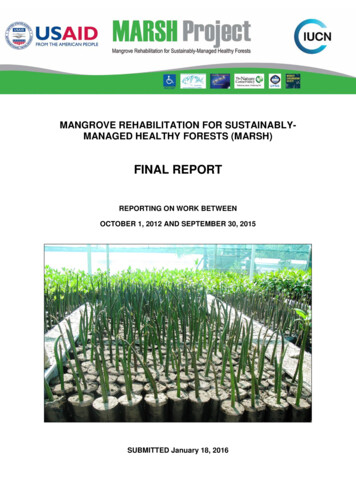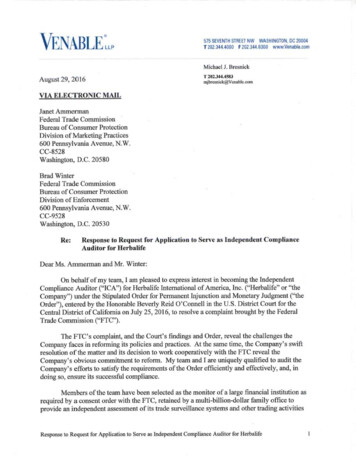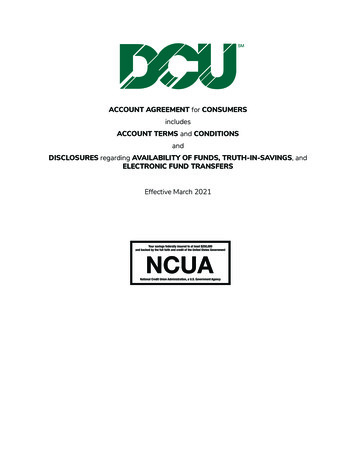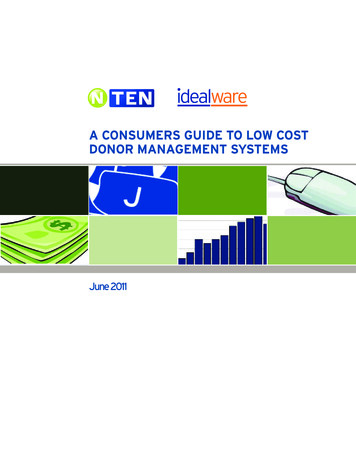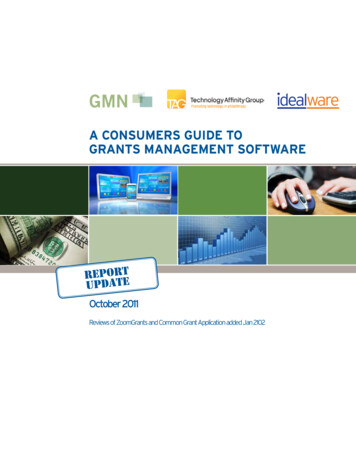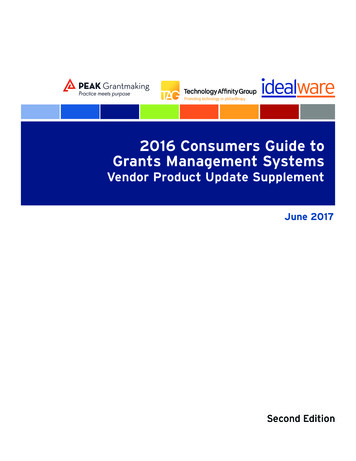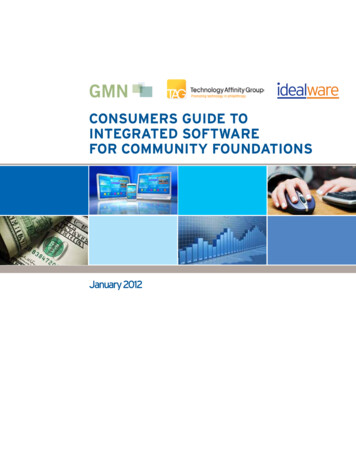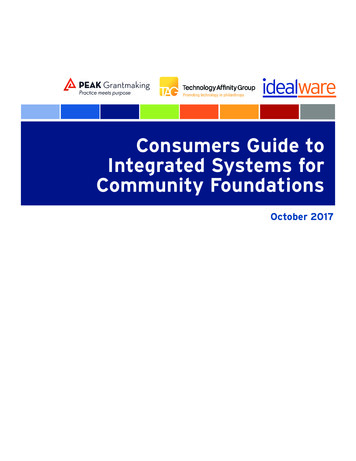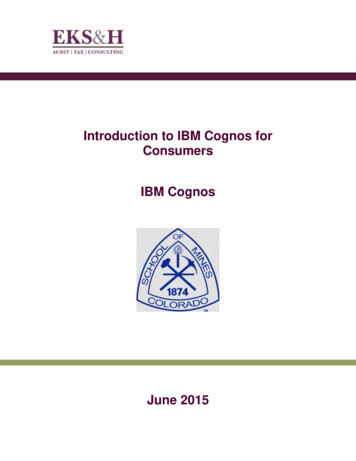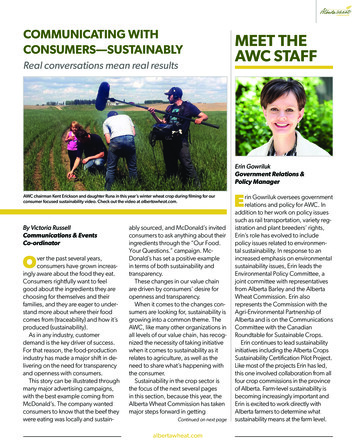
Transcription
COMMUNICATING WITHCONSUMERS—SUSTAINABLYReal conversations mean real resultsMEET THEAWC STAFFErin GowrilukGovernment Relations &Policy ManagerAWC chairman Kent Erickson and daughter Runa in this year’s winter wheat crop during filming for ourconsumer focused sustainability video. Check out the video at albertawheat.com.By Victoria RussellCommunications & EventsCo-ordinatorOver the past several years,consumers have grown increasingly aware about the food they eat.Consumers rightfully want to feelgood about the ingredients they arechoosing for themselves and theirfamilies, and they are eager to understand more about where their foodcomes from (traceability) and how it’sproduced (sustainability).As in any industry, customerdemand is the key driver of success.For that reason, the food-productionindustry has made a major shift in delivering on the need for transparencyand openness with consumers.This story can be illustrated throughmany major advertising campaigns,with the best example coming fromMcDonald’s. The company wantedconsumers to know that the beef theywere eating was locally and sustain-ably sourced, and McDonald’s invitedconsumers to ask anything about theiringredients through the “Our Food.Your Questions.” campaign. McDonald’s has set a positive examplein terms of both sustainability andtransparency.These changes in our value chainare driven by consumers’ desire foropenness and transparency.When it comes to the changes consumers are looking for, sustainability isgrowing into a common theme. TheAWC, like many other organizations inall levels of our value chain, has recognized the necessity of taking initiativewhen it comes to sustainability as itrelates to agriculture, as well as theneed to share what’s happening withthe consumer.Sustainability in the crop sector isthe focus of the next several pagesin this section, because this year, theAlberta Wheat Commission has takenmajor steps forward in gettingContinued on next pagealbertawheat.comErin Gowriluk oversees governmentrelations and policy for AWC. Inaddition to her work on policy issuessuch as rail transportation, variety registration and plant breeders’ rights,Erin’s role has evolved to includepolicy issues related to environmental sustainability. In response to anincreased emphasis on environmentalsustainability issues, Erin leads theEnvironmental Policy Committee, ajoint committee with representativesfrom Alberta Barley and the AlbertaWheat Commission. Erin alsorepresents the Commission with theAgri-Environmental Partnership ofAlberta and is on the CommunicationsCommittee with the CanadianRoundtable for Sustainable Crops.Erin continues to lead sustainabilityinitiatives including the Alberta CropsSustainability Certification Pilot Project.Like most of the projects Erin has led,this one involved collaboration from allfour crop commissions in the provinceof Alberta. Farm-level sustainability isbecoming increasingly important andErin is excited to work directly withAlberta farmers to determine whatsustainability means at the farm level.
involved and leading the wheat industry forward—sustainably.You will learn more about theAlberta Crops Sustainability Certification Pilot Project, a major initiativethat the Alberta Wheat Commissionis leading in collaboration withAlberta Barley, the Alberta CanolaProducers Commission and AlbertaPulse Growers, as well as the peoplebehind the work. And you will learnabout a research initiative we areinvesting in that supports sustainablefertilizer application.While farmers have always beenstewards of the land, they are eagerto share their stories with consumersto gain social licence. That’s why, withsustainability, we’ve taken it upon ourselves to deliver on the transparencyconsumers are looking for and sharethese initiatives with you. We want toshare the good-news stories comingout of Alberta’s fields and tell youabout all the work farmers are doingto ensure that you’re proud to buyAlberta-grown food.But there’s more than that—wewant to hear from you. We want tolearn what sustainability means to youand how it impacts your day-to-daylife. We want to share your voice withfarmers in the same way we share thestories of our 14,000 farmer memberswith you. Our strategy is about findingopportunities to be accountable andtransparent to our growing consumermarket. Ultimately, you are our endusers, and talking candidly with youis one approach to bridging the gapbetween city and farm.To share farmers’ sustainability stories, we’ve developed a video that talksabout some of the work we are doingwith farmers. We encourage you towatch the video at albertawheat.comand learn more about what farmers aredoing every day to preserve the landused to grow safe, high-quality cropsfor generations to come.SPOTLIGHT ONRESEARCHFertilizer managementfor sustainable cropproductionBy Hannah KonschuhResearch ManagerThere is increasing pressure forcrop production in Western Canada to be sustainable, largely to gainsocial licence with consumers. Now,more than ever, consumers want tobe sure their food has been grown inan environmentally responsible way,while maintaining the high qualitystandards that Canadian-grown foodis known for.The Alberta Wheat Commission isinvesting in a project led by Dr. MilesDyck, a University of Alberta professorwho aims to build on scientific knowledge supporting best managementpractices for fertilizer application.Dyck’s project will study theefficiency of co-ordinated long-termfertilization practices. Using valuablelong-term data from the University ofAlberta’s Breton Classical Plots, whichhave been maintained under variousfertility treatments since the 1980s,Dyck will study the interaction and potential benefits of long-term nitrogenand sulphur application and the effecton fertilizer use efficiency.“Efficient use of fertilizer nitrogenrequires an adequate supply of sulphur and other macronutrients (P, K),”said Dyck. “Soil sulphur deficiencymay be increasing because of greaterfrequency of crops with high sulphurdemands (canola, pulses) in rotationsalbertawheat.comUniversity of Alberta research staff collecting samples in the Breton Classical Plots. Photo: Courtesy ofDick Puurveen, University of Alberta.and because of decreased atmospheric deposition following stricterindustry regulation.”The benefits of employing bestmanagement practices are twofold:first, they help maximize the efficiencyof applied fertilizer, thus contributingto farm profitability, and second, theyhelp avoid negative environmentalimpacts often associated with fertilizer use. For example, efficient use offertilizer reduces the amount of nitrousoxide, an important greenhouse gas,released from soil into the atmosphere.“The goal of this work is to encourage farmers to adopt best management practices to improve long-termfertility and sustainable crop production as well as to meet the increasingenvironmental performance demandsrequired for market access.”The project is being co-funded bythe Alberta Wheat Commission andthe Alberta Crop Industry Development Fund, with a total fundingcontribution of 124,000.Information on this initiative andothers in AWC’s research portfoliocan be found at albertawheat.com/research. Check back for updates.
SUSTAINABILITY BEGINS AT THE FARMBy Erin GowrilukMore and more, we are hearingfrom multinational companieslike McDonald’s, Unilever, Kellogg’s,General Mills and Anheuser-Buschthat their customers are demandingproducts that contain sustainablysourced ingredients. In response tothese demands, these companieshave developed key performance indicators or “sustainability metrics” thatwill be applied to the entire supplychain, starting at the farm.So what does sustainability look likeat the farm level? How will these metrics be applied to on-farm practices?How do we know what, if anything,needs to change about the way wefarm in order to maintain access to keyexport markets? The answer is that wedon’t know—but we’d like to find out.In March 2015, representatives fromAlberta’s four crop commissions—Alberta Barley, the Alberta CanolaProducers Commission, Alberta PulseGrowers and the Alberta Wheat Commission—underwent on-farm assessments in three major, internationallyrecognized sustainability certificationprograms.The first program was the International Sustainability and CarbonCertification (ISCC) PLUS. The standard seeks to demonstrate farmercompliance with global sustainableagriculture requirements. It is certifiable by independent certification bodies, recognized by the global marketand employed by farm groups acrossNorth America. The European Commission recognizes it as one of the firstcertification schemes to demonstratecompliance with the European Union’srenewable energy directives.AWC director Kevin Bender and Control Union auditor Doug Higgins during Higgins’s sustainabilityassessment for the Alberta Crop Sustainability Certification Pilot Project. Photo: Rob McMorris.The second program was the Sustainable Agriculture Initiative’s FarmerSelf Assessment 2.0. This platform isthe main food and beverage industryinitiative supporting the developmentof sustainable agriculture initiativesworldwide. The organization strivesto develop sustainable agriculturethrough a continuous improvementprocess that allows for a more flexible adoption by farmers. Relevantmembers include Anheuser-Busch,Heineken, Kellogg’s, General Millsand McDonald’s.The third and final program included in the on-farm assessments wasthe Unilever Sustainable AgricultureCode. This scheme was developed in2010 as part of Unilever’s continuousimprovement efforts. It was createdand tested by a network of practicalagronomists, farmers, consultants andsustainability advisors, and is appliedto agricultural raw materials sourcedby Unilever.The purpose of this project isthreefold. First, our farmer membersalbertawheat.comwant to better understand consumerexpectations around agriculture andsustainability, and we believe thatthese consumer-driven programs arethe most efficient and effective meansto collect that information. Second,farmers also want to contribute tothis important conversation, and thisproject will prepare them to addressconsumer expectations in relation tothe on-farm practices employed inmodern agriculture. Finally, we wantto assess farmer readiness. Thesesustainability programs are not aboutsatisfying a niche market. Farmers’ability to satisfy these requirementswill determine whether or not theycan access major markets in the future.Project results will identify any gaps orareas where farmers could considermaking some changes. We are veryconfident that Alberta farmers arepoised and ready to meet the challenge, and that will be demonstratedin the many improvements that havealready been made on farms acrossthe province over the years.
SERVING ALBERTA’S WHEAT PRODUCERSMandated by Alberta’s Marketing of Agricultural Products Act and funded through a mandatory, refundable checkoff, the Alberta Wheat Commission has established our place as an organization that serves, guides and helpsshape the evolving wheat industry on behalf of 14,000 wheat producers in our province. Our mission is to increase thelong-term profitability of wheat and Alberta wheat producers. We carry out our mission though our four program areas,led by our management team and guided by our farmer directors and regional representatives.RESEARCHThrough our research program, AWC is investing over 1.7 million per year in innovativeresearch and development that aims to meet customer requirements and sustain the reputationfor high-quality ingredients that Alberta-grown food is known for. Our key priorities are improving genetics, agronomic performance, and resistance to diseases and pests.MARKET DEVELOPMENTAWC plays a key role in building the Canadian wheat brand and developing international markets as part of a larger “Team Canada” approach. Canadian wheat is known on the world stagefor its high quality parameters, and, subsequently, approximately three-quarters of Canadianwheat is exported to key markets such as Japan, Southeast Asia and the United States. We arealso proud to continue building relations with Canadian markets to ensure that Canadians haveaccess to the high-quality food grown in their own backyard.Another major initiative led by our Markets team is development of a new website, that willsignificantly improve farmers’ ability to make well-informed marketing decisions and maximizethe value of their crops. Known as PDQ, short for Price & Data Quotes, the site will provideinformation on cash grain prices for a broad range of commodities as well as data on grainmovement and trade. A test version of PDQ has been established at pdqinfo.ca.GOVERNMENT RELATIONS AND POLICYAWC has an active hand in collaborating with our federal and provincial governments, as wellas partnering organizations, to identify policy issues and develop advocacy initiatives that helpaddress issues faced by producers. Through these initiatives, our policy program also strives toencourage investment in Alberta’s wheat industry.Over the past year, AWC has focused its policy and government-relations efforts primarily onkey national issues affecting producers, including rail transportation, crop-variety registrationin Canada and amendments to the Plant Breeders’ Rights Act. We are also building our place inthe on-farm sustainability conversation by leading the Alberta Crops Sustainability CertificationPilot Project in collaboration with Alberta Barley, the Alberta Canola Producers Commission andAlberta Pulse Growers. This initiative will assess producers’ readiness to meet growing consumer demand for sustainable food production.COMMUNICATIONS, GROWER RELATIONS AND EXTENSIONOur Communications and Grower Relations program is integral in building the AWC brandby actively communicating the initiatives we lead and collaborate on with our 14,000 farmermembers. We also have a visible presence throughout the year at trade shows, crop walks andconferences, making ourselves available to both our farmer and consumer audiences.AWC recognizes that the continued development of both current and prospective farm leaders is critical to the future of the wheat industry. This means we have made it a priority to provideeducation and scholarship opportunities, share knowledge, and encourage skills developmentin people of all ages.albertawheat.com
Marketing and events co-ordinator, Lauren Reid, brings Alberta Barley to agriculture events across the province.BRINGING AGRICULTURE TO THE BIG CITYBy Sydney DuhaimeLike most people born and raisedin the city, Lauren Reid, marketingand events co-ordinator for AlbertaBarley, was a relative newcomer toagriculture.“I didn’t come from a farmingbackground,” the Calgary native explained. “As a city kid, you don’t oftenthink about where your food comesfrom.”However, after a year at AlbertaBarley, Reid has quickly learned howmuch of an impact agriculture hason the daily lives of Albertans. “Fromseeding to harvest, and how ourfood gets to the grocery store, it’sincredible how complex and multifaceted the whole process is,” saidReid. “However, as a consumer, thesewere the things that rarely crossed mymind.”Nowadays, Reid is working tochange that. As the face of AlbertaBarley at events across the province,she has the unique opportunity tointeract with the general public and introduce barley to kids and adults alike.“We attend a lot of educationalevents across the province,” Reidexplained. “Our largest educationalevents are Agrium’s Ag-tivity in the Cityduring the [Calgary] Stampede andAggie Days in Calgary and Lethbridge,and City Slickers in Stony Plain.”These events are a great way toconnect with kids and parents andexplain how their food gets from farmto plate, Reid said. “It’s an opportunity to dispel myths about agricultureand talk about the health benefits ofalbertabarley.combarley. People are often surprised athow versatile barley is and that thislocal food can be used for more thanbeer and soup.”But the benefits don’t end there.With the lines of communicationopen, consumer events are also agreat way to exchange knowledgeand ideas with an inquiring public.After all, people have questions—andthe world of agriculture is alwayshappy to provide the answers.“These events bridge the gap between farmers and consumers,” saidReid. “They provide a place wherefarmers and consumers can cometogether to have a conversation abouttheir food.”For more information on AlbertaBarley’s upcoming events, visitalbertabarley.com.
EXPLORING THEUNKNOWNBy Gen HandleyCreating new barley varieties canbe a deeply personal experiencefor breeder Patricia Juskiw. “I alwayssay that these plants are like mychildren, and I’m disappointed whenthey don’t do well,” she said, laughing. “And I’m also very happy whenthey do go to market and becomesomething.”One of the “children” doing well isthe Canmore variety, which, thanksto the help of Alberta Barley, had itsmarketing rights licensed by CanterraSeeds in 2013. Japan’s Sanwa Shuruipartnered with Alberta Barley tofind a suitable barley variety to makeshochu, a distilled alcoholic beveragethat outsells the popular sake in theLand of the Rising Sun.“It’s a very popular liquor,” saidGarson Law, Alberta Barley’s researchmanager. “But there isn’t enoughbarley grown in Japan to meet the demand, so there is an excellent opportunity for Canadian barley growers.”The shochu barley project, fundedby Alberta Barley, was an excellentThe Canmore barley variety near the end of the growing season.opportunity to combine the Commission’s top priorities: research andmarket development. Started in theearly 2000s, the project aimed to lookat 15 to 20 varieties of barley for thespirit each year. While some varietieshave shown promise, Canmore is theonly one that has reached the level ofcommercial development.“The Japanese market represents apotentially very large export opportunity for Canadian barley,” Law said.“The aim of the shochu project isto determine varieties of CanadianCanmore Breeding: A Brief History200220032004Two varieties,Ponoka and H92013289Z,were crossbred.Their offspring was thenself-pollinated and grown in aclimate-controlled chamber.The new seeds were grown inbulk first at the Lacombe FieldCrop Development Centre andthen in California. Two hundredheads, the portion of the plantthat contains the seeds, wereselected to continue testing.The selected seeds returnedto Lacombe to be grown andstored for the next season.albertabarley.com2005These seeds spawnedtwo more generationsand were planted intorows. The top 30 rowswere selected for harvestand studied for their feedand malting quality.
barley that are suitable for makingshochu.”Brent Derkatch, director of operations and business developmentat Canterra Seeds, said Canterrawas very impressed with the barleyvariety. “The variety has a very strongagronomic package and it yieldsreally well—in fact, it’s one of thehighest-yielding barley varieties available,” he said. “It also has very strongstraw, meaning it has improvedlodging resistance, and this is a veryimportant characteristic for farmers.Additionally, quality tests so far haveshown it to have very plump kernelswith more starch, which is desirablefor shochu manufacturing.”With the project, Alberta Barley andits partners are developing modernways to look at a traditional beverage.“We’re trying to determine whatproperties create a great-tasting,fermented product,” Law explained.“It’s the big unknown, the crux of ourresearch project.“This is a centuries-old process thathas always been conducted at thelocal level by independent distilleries.For the first time, we’re looking at theunderlying chemistry behind shochu,and that’s exciting,” said Law. “In thepast, we didn’t have the analytical2006-20092010The seeds were grownin Lacombe and acrossWestern Canada foryield testing.Japanese companySanwa Shurui Co. Ltdalso selected this newvariety for furtherevaluation in shochuproduction.Barley breeder Patricia Juskiw stands in front of test plots of Bentley and TR10694 (Canmore).Photos: Field Crop Development Centre, Lacombe.2011-2012Sample testingcontinued.20132015The test variety was recommendedfor registration. In Canada only registered varieties can be sold to farmersfor mass production. Canterra Seedsreceived the marketing rights for thetest variety and named it Canmore.Canmore is in production to increase stockand is expected to beavailable for the 2016growing season.albertabarley.com
capacity to study those components,but now we do.”By developing different barleyvarieties, the industry is delivering aproduct that will meet demand andcater to consumers’ preferences.“Consumers and end users demandthe best—they appreciate qualityingredients more than ever,” saidDerkatch. “We are starting to seemore interest from companies likeSanwa Shurui to get involved in thedevelopment and production of theiringredients—they are also seeking tounderstand the quality characteristicsof their ingredients and how thatimpacts their product. In the long run,that means varieties like Canmore areviewed more as ingredients and lesslike commodities.”Though Canmore was originallytested for both malt and shochuproduction, it ultimately did not meetthe requirements for malt. However,Canmore offers a great mix of starch,protein and other components thatmake it ideal for distilling into an alcoholic beverage such as shochu.“I was shocked; I couldn’t believethe alcohol yields we get in thisvariety. But it also has good-qualitytraits; it has good pearling traits andgood flavours,” said Juskiw. “It reallyworked out.”Law explained that while the current market is small, growing barleyfor shochu could be a good opportunity for farmers. “It’s a niche market,but there may be farmers out therelooking to get into something a bitdifferent.”But he noted that there needs to beexport infrastructure in place in orderfor growers to benefit.“ Canmorecould pave the way for that,” said Law.As for Juskiw, she believes Canmore wouldn’t be where it is withoutAlberta Barley’s help. “Canmore itself,and it being released as a food barley,wouldn’t have been possible withoutAlberta Barley—they helped it getregistered,” she said. “Once it wasregistered, it was kind of like gettingan award of merit—pretty exciting.”2015 ANNUAL GENERAL MEETINGDecember 9 – 10, 2015Banff Springs Hotelalbertabarley.com
the Unilever Sustainable Agriculture Code. This scheme was developed in 2010 as part of Unilever’s continuous improvement efforts. It was created and tested by a network of practical agronomists, farmers, consultants and sustainability advisors, and is applied to agricultural raw materials sourced by
